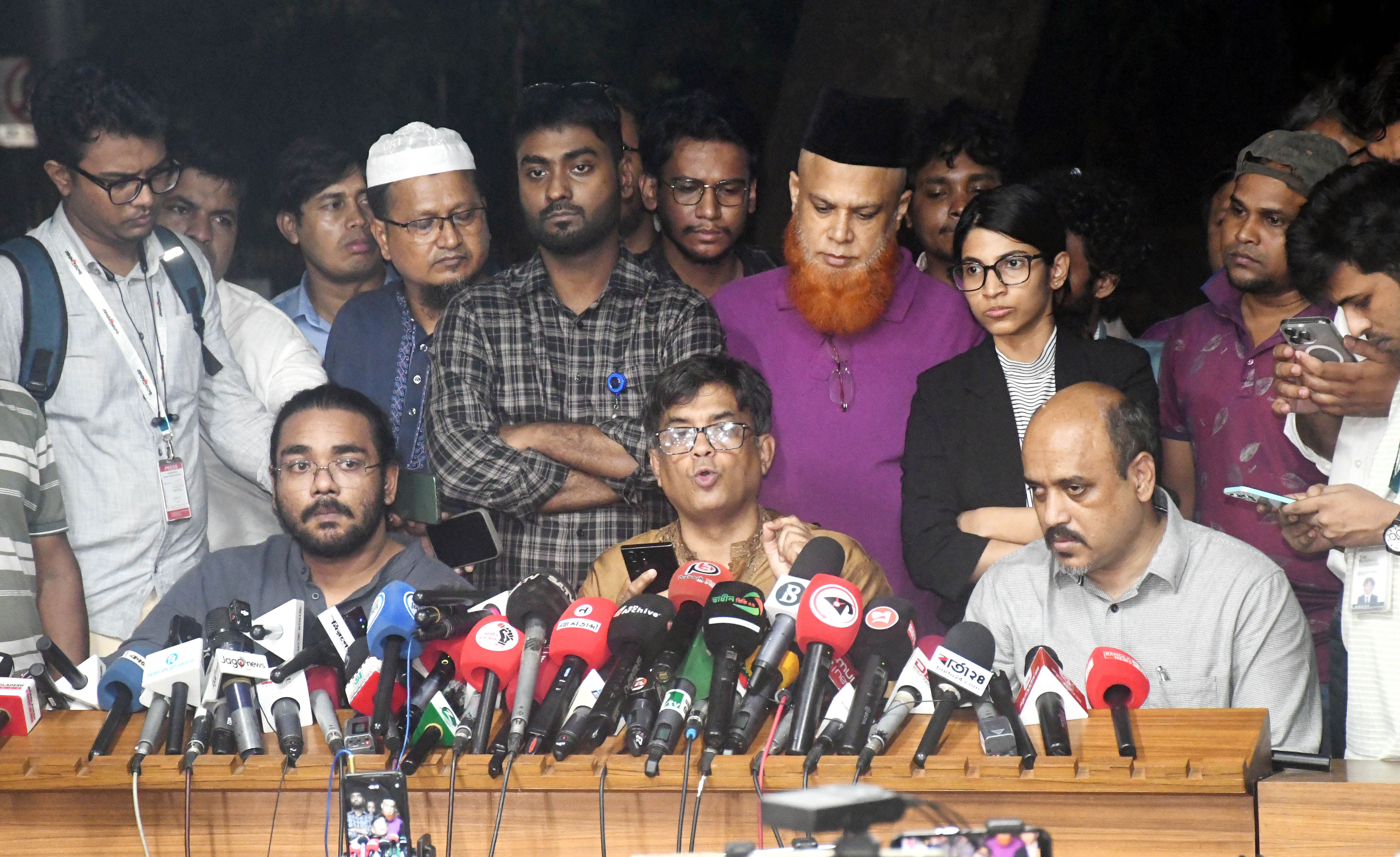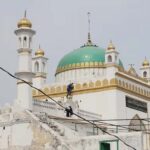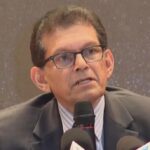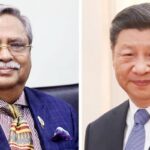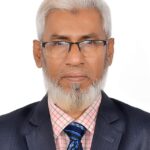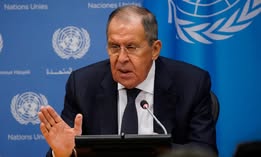
INSIDE RUSSIA
Moscow is “finalizing” its draft peace proposal it plans to present to Kiev once a major prisoner exchange is over, Sergey Lavrov has said
Russian Foreign Minister covered a broad range of topics related to the Ukraine conflict settlement as well as Moscow’s view on the roles the US and the EU play in this process during several events on Friday.
Addressing an international conference in Moscow and talking to journalists during a Q&A session later, the top diplomat spoke about the future of Ukraine’s Vladimir Zelensky’s and the Kiev “regime,” as well as Washington’s role in mediating the conflict and the responsibility the EU bears for protracting the hostilities.
Here are the key takeaways from his statements.
Ukraine peace process
Lavrov emphasized that Russia remains open to renewed negotiations, provided they focus on the root causes of the conflict and acknowledge the current realities on the ground.
He said that Russia is currently “actively working” on a memorandum outlining steps toward a potential peace agreement and plans to deliver it to the Ukrainian side.
According to the minister, Moscow would be ready to present its draft peace proposal to the Ukrainian side once the major POW exchange is over. On Friday, the two sides started the swap agreed in Istanbul last week. The exchange is expected to continue over the weekend.
So far, no new meeting date for the Russian and Ukrainian delegations has been set, Lavrov stressed. The sides agreed to resume contact once each of them prepares a detailed draft peace proposal. The minister also objected to ceasefire suggestions that would place no restrictions on Ukraine’s interactions with the West, arguing that such a truce would simply allow Kiev to rearm its forces.
Russia’s top diplomat described as “not very realistic” the possibility of holding the talks in the Vatican, as had been proposed by Pope Leo XIV. It would be “inelegant” for two Orthodox Christian countries to mediate their conflict in the capital of the Catholic faith, Lavrov said.
Zelensky’s status
Vladimir Zelensky’s legitimacy will be of key importance when it comes to signing a peace agreement with Ukraine, Lavrov stressed. If any future deal is signed by someone whose “legitimacy no longer convinces anyone,” successors may question the reached agreements, he cautioned.
Zelensky’s presidential term expired last year but he has remained in power by refusing to hold new elections citing martial law.
The Russian diplomat stated that Russia is not rejecting contact with Zelensky or his administration and is willing to engage in discussions about settlement principles.
Future of Kiev regime
Lavrov described the current Ukrainian government as a “junta” and condemned its policies targeting the Russian-speaking population. Leaving millions in Ukraine under the rule of a regime that has banned their native language would be “a major crime,” he said.
If Zelensky’s “junta” expects that “somehow an agreement will be reached to end the hostilities, and what remains of Ukraine will live according to the laws that they adopted, this is an illusion,” the minister added. “This cannot be allowed under any circumstances,” he stressed.
Russia-US relations
Lavrov welcomed US President Donald Trump’s efforts to mediate peace in the Ukraine conflict.
The minister noted that Trump was the first Western leader who “publicly said that drawing Ukraine into NATO was a grave mistake” and blamed the administration of his predecessor, Joe Biden for the escalation of the conflict.
Russia is open to cooperation with the US on space, energy, and technology – provided it is based on equality and mutual benefit. However, Lavrov acknowledged that US foreign policy has historically shifted unpredictably and that Russia takes this into account when planning its actions.
Security crisis in Europe
The European continent is facing a “deep security crisis” that the EU leaders seek to exploit to facilitate its militarization, the foreign minister warned. According to Lavrov, the “Euro-Atlantic security structures have fallen short” of providing real security for the continent.
Russia is supporting a concept of a Eurasian security architecture that would involve all nations of the Eurasian continent instead of a purely Western one, he said. According to Lavrov, Russia does not want to “fence itself off from NATO” but seeks instead an inseparable security structure for “all the nations of Eurasia, including its Western part.”
It is NATO and not Russia that “harbors plans of subduing … all of the Eurasian continent up to the far east,” the minister warned.
EU ‘responsibility’ for continued bloodshed
The EU leaders are “fueling” the Ukraine conflict and encouraging Zelensky and his “regime” to continue the hostilities against Russia, Lavrov told journalists during the Q&A session. Calls by French President Emmanuel Macron, British Prime Minister Keir Starmer, and German Chancellor Friedrich Merz on Russia to agree to an “unconditional ceasefire” are a disguise for their plans to continue pumping the Kiev “regime” with arms, the foreign minister has stated.
The EU leaders seek to disrupt the peace process renewed during the direct talks between the Russian and Ukrainian delegations in Istanbul last week, Lavrov believes.
“They’ve bet their reputation on dragging Europe into a war against Russia to facilitate the militarization of Europe,’ the minister warned, adding that the Western governments plan to allocate “huge sums” of money for that goal.
“There is certainly Europe’s responsibility” in protracting the Ukraine conflict, Lavrov said adding that the EU leaders would “find it hard to shed this responsibility.”
Russia and India vow joint fight against terrorism
Indian lawmakers have made a three-day visit to the Russian capital to discuss the recent standoff with Pakistan
Moscow and New Delhi have confirmed “a decisive commitment to an uncompromising joint fight against all forms of terrorism,” the Russian Foreign Ministry said following high-level talks with an Indian parliamentary delegation in the capital this week.
According to both sides, discussions focused on strengthening cooperation in regional and global forums, including the UN, BRICS, and the Shanghai Cooperation Organization. Indian officials said Russia’s support reflects the deep trust between the two countries and comes at a critical moment in the face of growing regional challenges.
“The Indian side reiterated its zero-tolerance policy towards terrorism and stressed that India will not tolerate any nuclear blackmail,” the Indian Ministry of External Affairs stated.
The Russian Foreign Ministry reported that the two sides discussed enhancing cooperation on security and counter-terrorism in regional and global forums, particularly in the United Nations, BRICS, and the Shanghai Cooperation Organization (SCO). “A decisive commitment to an uncompromising joint fight against all forms of terrorism was confirmed,” the ministry stated.
Presenting New Delhi’s viewpoint on its recent diplomatic and military standoff with Pakistan – which escalated after 26 Indians lost their lives in a terrorist attack in Kashmir on April 22 – the head of the delegation, DMK party MP Kanimozhi Karunanidhi, explained that India’s response had been both necessary and non-escalatory.
She also echoed Prime Minister Narendra Modi’s recent remarks that India would react strongly to terrorist attacks and would make no distinction between terrorists and their sponsors. “We do not want to suffer in silence as we have done in the past,” she said, emphasizing that India has been facing security threats for decades.
Moscow was chosen as the delegation’s first stop, with subsequent visits planned to Slovenia, Latvia, and Spain. Indian lawmakers and former diplomats emphasized that the long-standing ties with Russia and the high level of trust between the two governments contributed to the success of the visit.
“We naturally seek an understanding that Russia is by our side in this time of difficulty. It is better that people are aware of our suffering from state-sponsored terrorism by Pakistan,” the delegation members told the media on Saturday.
Defense cooperation was also discussed, with the effectiveness of Russian-made equipment – including the S-400 air defense systems supplied to India in recent years, as well as BrahMos missiles co-developed by India and Russia, being highlighted by Indian military officials and experts.
Work on Ukraine peace memorandum at ‘advanced stage’
A new round of talks between Moscow and Kiev will take place, but the Vatican is not “a very realistic” venue, the Russian FM has said
Moscow is at an “advanced stage” in preparing a memorandum that outlines steps toward a potential peace agreement with Ukraine, Russian Foreign Minister Sergey Lavrov said on Friday.
Addressing a conference in Moscow, Lavrov reiterated Moscow’s readiness to continue dialogue with Kiev, following the resumption of talks in Istanbul earlier this month after a three-year pause.
“Yes, we support the idea of talks. There will be a second round of negotiations. They [the Ukrainian side] have confirmed this. This is already a positive development,” he said.
Russian President Vladimir Putin said on Monday that he had agreed with US President Donald Trump that the next move toward resolving the Ukraine conflict should be a memorandum outlining the principles and timeline for a peace settlement.
When asked about the progress in preparing the memorandum, the Russian foreign minister said: “I don’t know about the other side, but our work is already at an advanced stage. And in any case, we will hand over this memorandum to the Ukrainians, as we agreed, and we will expect that they will do the same.”
The timeframe for the next meeting between the Russian and Ukrainian delegations has “not yet been determined,” he said.
“Many people are speculating about when and where it might happen. We do not have any ideas at the moment,” Lavrov added.
Lavrov noted the offer from the Vatican, supported by Trump, to host further talks between Moscow and Kiev, but described the likelihood as “not very realistic.”
“Well, it is a little awkward, I would say. When Orthodox countries are using a Catholic platform to discuss issues related to eliminating root causes [of the conflict between them],” Lavrov said.
“One of those root causes is the course towards the destruction of the [canonical] Ukrainian Orthodox Church (UOC)” by the government in Kiev, the minister noted.
Kiev has accused the UOC of maintaining ties to Russia, despite the church’s formal declaration of independence from the Moscow Patriarchate in May 2022. The crackdown has included multiple arrests of clergy and raids on church properties. One of the most high-profile incidents occurred in the catacombs of the Kiev Pechersk Lavra, where sacred relics are housed.
OUTSIDE RUSSIA
Kiev’s Western backers to blame for massive drone strikes on civilians
The EU and the UK want to disrupt the Ukraine conflict peace talks by emboldening Kiev to attack Russian civilians, Sergey Lavrov has said
Kiev’s Western backers, including the EU and the UK, bear responsibility for the latest series of Ukrainian drone strikes targeting Russian civilians, Foreign Minister Sergey Lavrov has told a Q&A session in Moscow. Western nations want to disrupt the renewed peace talks between Russia and Ukraine as they pursue their narrow political goals, he said.
The minister was referring to a series of large-scale drone raids launched by Kiev’s forces this week. According to the Russian military, 776 drones and 12 missiles were intercepted above the country’s territory between Tuesday and Friday morning, while 12 drones hit their targets. On Saturday morning, the Russian Defense Ministry reported that another 104 UAVs had been intercepted inside Russia overnight.
Kiev’s aggressive actions are due to the support that “some European nations led by the UK, France, Germany, and the EU leadership” lend to the “Ukrainian Nazis,” Lavrov said on Friday. “We are convinced that they bear their share of responsibility for these crimes,” he stated, adding that Moscow would seek to “put an end to this policy.”
Lavrov said the goal of Kiev’s backers was to disrupt the peace talks that were renewed in Istanbul last week after President Vladimir Putin offered to resume negotiations without any preconditions. Russia is currently “actively working” on a draft peace proposal and will be ready to present it to the Ukrainian side following a major prisoner exchange being carried out by Moscow and Kiev over the weekend, he said. Moscow is committed to peace “despite any provocations,” the minister stated.
The EU and the UK are only “fueling” the conflict and encouraging Ukraine’s Vladimir Zelensky and his government to continue the bloodshed, Russia’s top diplomat said. Even their calls for an immediate and unconditional ceasefire are a disguise for a desire to continue pumping Ukraine with weapons, Lavrov believes.
“They’ve bet their reputation on dragging Europe into a war against Russia to facilitate the militarization of Europe,” the minister warned, adding that Western governments plan to allocate “huge sums” of money to that goal.
“There is certainly Europe’s responsibility” in prolonging the Ukraine conflict, Lavrov said. He added that EU leaders would “find it hard to shed this responsibility.”
SPECIAL MILITARY OPERATION IN UKRAINE
Russian military strikes drone-making plant in Kiev
Other targets included a surveillance center and a US-made Patriot air defense system, the defense ministry has said
The Russian military has carried out a successful strike against a drone and missile production plant in the Ukrainian capital, Kiev, the Defense Ministry in Moscow has said.
The statement, issued by the ministry on Saturday, confirms earlier reports of a large-scale Russian drone and missile strike on Kiev overnight. Witnesses said they heard multiple blasts, with photos uploaded on social media capturing a huge explosion in the city.
“The Russian military performed a group strike with high-precision ground-based weapons and unmanned aerial vehicles against a Ukrainian military-industrial complex enterprise that produces missile weapons and unmanned aerial attack vehicles,” the statement read.
The other targets of the attack were a radar surveillance center and a US-made Patriot air defense system, it added.
“All of the goals of the strike were achieved. All designated targets were hit,” the ministry said.
According to media reports, the Russian strike targeted the Antonov aircraft manufacturing plant in the western part of the capital.
The Russian bombardment came after an intensification of Ukrainian drone attacks on Moscow and other Russian regions this week.
According to the Defense Ministry, 788 drones and 12 missiles were intercepted inside Russia between Tuesday and Friday. Another 104 UAVs were intercepted overnight, the ministry said on Saturday morning.
The Russian Foreign Ministry said on Friday that one person had been killed and 20 others injured, including four children, in Ukrainian drone strikes throughout the week. Four more civilians, including two kids, were wounded after the city of Lgov in Kursk Region was hit by a US-supplied HIMARS multiple rocket launcher, according to the ministry.
The Russian military said it would respond appropriately to the intensified drone raids by Kiev, but “unlike the Ukrainian side, our targets will be strictly limited to military facilities and defense industry plants,” it said.
Kiev’s drone raids meant to derail peace process
Russia’s commitment to peace dialogue remains unchanged, the Russian Foreign Ministry has said
Ukraine is trying to derail direct peace talks by intensifying drone strikes against non-military targets in Russia, the Russian Foreign Ministry said in a statement on Friday. It accused Ukraine’s “party of war” of conducting “terrorist attacks” against civilians in what it described as a political strategy to obstruct negotiations.
According to the Russian military, 776 drones and 12 missiles were intercepted above the country’s territory between Tuesday and Friday morning, while 12 drones hit their targets. On Saturday morning, the Defense Ministry in Moscow reported that another 104 UAVs had been intercepted inside Russia overnight.
“The Kiev regime is relentless in its terror attacks against civilians and civilian infrastructure in numerous Russian regions, including Moscow,” the Foreign Ministry said in a statement on Friday.
Over the course of just two days, one person was killed and 20 others – including four children – were injured in Ukrainian drone strikes. Four more civilians, including two children, were wounded when the city of Lgov in Kursk Region was hit by a US-supplied HIMARS multiple rocket launcher, according to the statement.
The strikes on non-military targets are “part of a strategy pursued by Ukraine’s party of war,” the ministry added.
“The latest barbaric terrorist attacks by the Kiev regime were carried out in an attempt to thwart direct Russia-Ukraine talks facilitated by the US administration [of President Donald Trump], which are aimed at settling the conflict definitively,” the Foreign Ministry stated.
The Russian military will respond appropriately to the intensified drone raids by Kiev, but “unlike the Ukrainian side, our targets will be strictly limited to military facilities and defense industry plants,” it said.
The Foreign Ministry concluded by stressing that Moscow’s “fundamental commitment to a constructive search for a peaceful settlement through dialogue remains unchanged.”
Direct talks between Russia and Ukraine resumed in Istanbul earlier this month after a three-year pause, with both sides agreeing to present detailed proposals of their vision of a ceasefire, to carry out a record 1,000 for 1,000 prisoner swap, which started on Friday, and to continue negotiations.
Russian Foreign Minister Sergey Lavrov said on Friday that Moscow is at an “advanced stage” in preparing a memorandum outlining the principles and timeline for a peace settlement with Ukraine. Russia will be ready to present its draft peace proposal by the time the two sides complete their latest military and civilian POW swap, he said.
The timeframe for the next meeting between the Russian and Ukrainian delegations has “not yet been determined,” Lavrov added.
Russia and Ukraine move forward with largest-ever POW swap
Moscow and Kiev have exchanged 307 POWs from each side, the Russian Defense Ministry has said
Another 307 Russian soldiers have been released as a result of a record prisoner exchange with Ukraine which was agreed on during the direct negotiations between Moscow and Kiev in Türkiye earlier this month, the Russian Defense Ministry has said.
The Russian troops have been sent to Belarus, where they are receiving psychological and medical assistance, the ministry explained.
The ministry announced on Saturday that “in line with the Russian-Ukrainian agreements reached on May 16 in Istanbul, another 307 Russian servicemen were returned from the territory controlled by the Kiev regime.”
It added that the Ukrainian side has received 307 of its POWs from Russia in return.
Moscow and Kiev agreed to a record 1,000 for 1,000 prisoner swap during the first direct talks between the sides in three years in Türkiye earlier this month. The exchange started on Friday, with 120 Russian civilians and 270 military personnel being released from Kiev’s captivity and an equal number of Ukrainian civilians and troops also returning home.
Later on Saturday, the troops departed Belarus and arrived in Moscow Region. They will now undergo further treatment and rehabilitation at the ministry’s medical facilities.
Moscow said that the large-scale exchange, initiated by the Russian side, will continue.
INSIGHTS
A new front: Russia expands into Ukraine to build a military buffer zone
Putin’s buffer zone aims to create space – both literally and politically – from Ukraine’s firepower
Russian President Vladimir Putin has officially announced the establishment of a “security buffer zone” along the border with Ukraine. Russian troops, according to the Kremlin, have already been ordered to push ahead and are actively targeting Ukrainian military positions near the frontier. The move is aimed at protecting Russian regions far from the front line – particularly Belgorod, Bryansk, and Kursk – which have faced frequent shelling, drone strikes, as well as sabotage missions launched by Ukrainian forces.
While talk of such a zone has circulated since 2023, Putin’s declaration marks a shift from concept to concrete policy. Here’s what this decision means, what it could look like militarily, and why the Kremlin is pursuing it now.
The long-waited announcement
On May 22, during a government meeting, President Putin declared that Russia had begun establishing a buffer zone along the Ukrainian border. He said the military had already started implementing the plan: “Our armed forces are actively carrying out this mission now. The enemy’s firing positions are suppressed, the work is going on”
Presidential spokesperson Dmitry Peskov confirmed the decision but declined to provide specifics, deferring to the Ministry of Defense. What is known is that the buffer zone will span areas bordering Ukraine in the Belgorod, Bryansk, and Kursk regions – all of which have suffered from Ukranian attacks.
From a military standpoint, a buffer (or “sanitary”) zone serves as a physical barrier meant to reduce the risk of direct clashes and provocations. These zones can be demilitarized, have restricted troop presence, or be fully occupied by military forces, functioning as a strategic cushion.
Historical parallels include Israel’s security zone in southern Lebanon (1985–2000), Türkiye’s cross-border operations in northern Syria (since 2016), the DMZ between North and South Korea (since 1953), and the so-called “gray zones” between Armenia and Azerbaijan prior to the 2020 Nagorno-Karabakh conflict.
Putin hinted at the need for such a zone as early as June 2023, citing the importance of denying Ukrainian forces the ability to strike Russian territory with artillery. Though details were vague at the time, the idea continued to surface in official rhetoric.
Lawmakers and military analysts have voiced support. The State Duma has proposed a buffer depth of at least 50–60 kilometers, equipped with air defenses and counter-drone systems. Dmitry Medvedev, Deputy Chairman of the Security Council, suggested that if Ukraine receives more long-range weapons, the zone might need to stretch even deeper – potentially up to 550–650 kilometers – to neutralize threats.
Meanwhile, Ukraine’s Foreign Ministry has condemned the initiative as a fresh escalation and called for increased international pressure on Moscow.
Current battlefield conditions
Militarily, establishing a buffer zone means expanding Russian control into Ukrainian territory.
The first signs of this appeared with Russian reports of capturing several villages in Ukraine’s Sumy region, including Maryino, Zhuravka, and Basovka – all close to the Kursk border.
Oleg Grygorov, head of the Sumy Regional Military Administration, acknowledged the sudden escalation, noting that Russian forces are employing small assault teams to entrench themselves in border villages.
As of late May, over 52,000 people had been evacuated from border areas. Ukraine began these evacuations weeks earlier, initially from Belopolye and Vorozhba villages, then extending to 202 localities.
Meanwhile Putin made a surprise visit to Kursk region on May 20 – his first since the fighting began there. During the trip, Pavel Zolotaryov, head of the Glushkovo District near the Ukrainian border, urged the president to take control of the city of Sumy to secure the area. Putin responded with a joke, noting that he had appointed Alexander Khinshtein as the new regional head because “he also wants more, more.”
Fighting is not limited to Sumy. Intense battles are also ongoing in Kharkov region near Kupyansk. Still, the scale of the current offensive doesn’t suggest an all-out operation aimed at encirclement. Instead, Russian advances appear slow and steady – likely designed to drain Ukrainian reserves and gradually expand control without making bold, risky moves.
The strategic rationale
There are several military and political motivations behind the timing of this push.
- Escalating cross-border threats:
Since spring 2023, attacks on Russian soil have intensified. Ukraine has received long-range Western weapons, including HIMARS, Storm Shadow missiles, and ATACMS. Cross-border shelling of Russian towns by tube artillery and multiple launch rocket systems (MLRS) has been relentless. Kiev’s M777 howitzers, with their 155mm caliber, have a firing range of up to 35–40 kilometers – and that’s roughly the distance separating major Ukrainian cities like Sumy and Kharkov from the Russian border.
Ukraine also relies heavily on drones and sabotage teams to penetrate Russian territory. There have been drone attacks deep inside Russia – including in Moscow – and armed incursions into border regions. These factors likely convinced Russian leadership of the need to push the front line further from its cities.
Putin has directly linked the buffer’s depth to the range of Ukraine’s foreign-supplied weapons – essentially saying: the farther they can reach, the deeper Russia will go to stay out of range.
- Leverage in negotiations:
This initiative may also be a tactical move to strengthen Russia’s hand in ongoing talks. A security buffer could be proposed as part of a broader ceasefire deal or even as a condition for halting the war. US envoy Keith Kellogg has floated the idea of a demilitarized zone, though Ukrainian Vladimir Zelensky has rejected any such arrangement. Still, the creation of a buffer could be on Russia’s wish list in any future peace talks – effectively demilitarizing parts of Sumy, Chernigov, or Kharkov regions.
- Long-term strategy:
Finally, the buffer zone fits within Russia’s broader approach to a prolonged war of attrition. Despite participating in negotiations, Moscow continues to signal its commitment to offensive operations. The buffer serves as both a tactical asset and a long-term defensive measure to shield vulnerable border areas.
What’s next?
From a military standpoint, creating a buffer zone is a logical move. Shifting the front 20–30 kilometers deeper into Ukraine would place major Russian cities like Belgorod and Kursk out of range for many artillery systems. It would also block infiltration routes for Ukrainian saboteurs and complicate drone operations.
Controlling more territory also disrupts enemy surveillance: the farther Ukrainian drones and recon units must travel, the less accurate and timely their data becomes.
But pushing deeper brings challenges. Each new advance demands expanded supply lines, new logistics hubs, air defenses, and engineering infrastructure – all while frontline troops remain exposed to air and artillery strikes. The burden on reserves grows, and the margin for error shrinks.
Fighting in Sumy and Kharkov continues at a measured pace. Should Russian forces manage to capture significant portions of these regions, major urban centers like Sumy and Chernigov – each home to hundreds of thousands – could fall within operational reach. Their vulnerability might prove a powerful bargaining chip in future negotiations.
